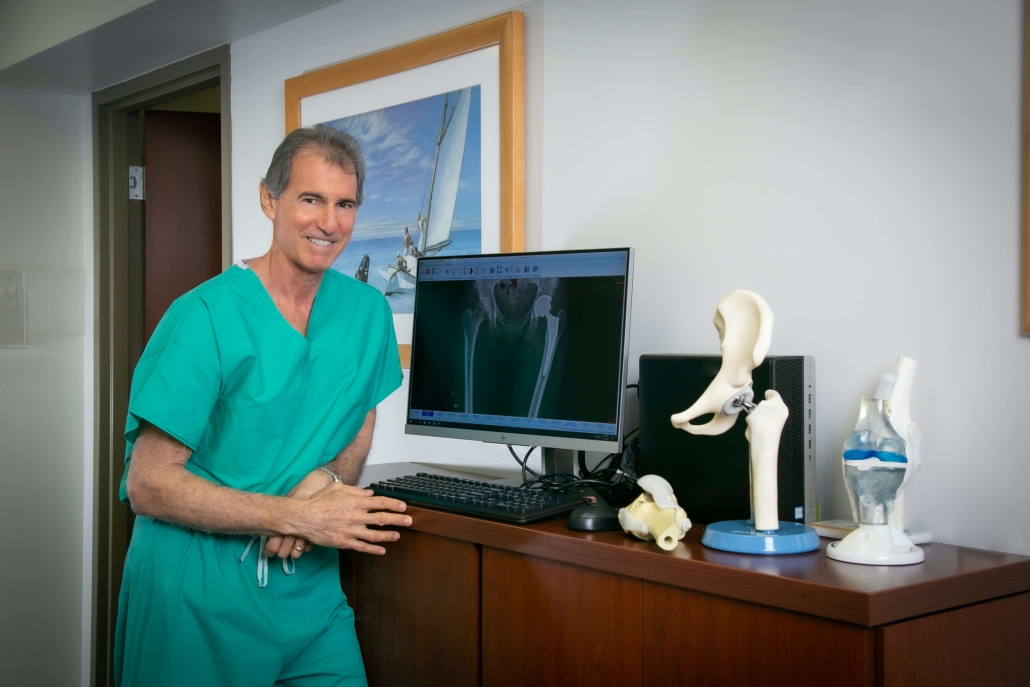Unhappy Total Hip Patient: Figuring Out What Is Wrong
Total hip replacement (THR) is one of the most successful and important surgeries developed over the past century. It has helped millions of people worldwide by relieving their pain and allowing them to remain mobile, independent and active. Multiple studies have demonstrated that more than 95-96% of people who undergo hip replacement surgery are happy with their result. This is wonderful unless you’re one of the 4-5% of individuals who have had a THR and not doing well. How do you figure out what’s wrong and how to get it corrected?
A thorough history is critical. I need to understand why someone is unhappy? Is it because their hip is dislocating? Or are they unhappy because they feel their leg was made longer or shorter and it’s hurting their back and making them limp? Or possibly because their hip hurts constantly and awakens them from sleep or because it hurts when they stand and walk but not at rest? Or were their expectations reasonable before surgery? These are just a smattering of reasons why someone might be unhappy after their hip replacement. It’s so important that I understand the “why” because these are “clues” that help us discover what went wrong and then directs the plan of how to correct.
This investigation starts with my understanding what was going on before the surgery. What was the diagnosis or problem that led to the need for replacement surgery? For example, was it a broken hip that made surgery necessary? If so, was a THR or partial hip replacement performed? Was the hip symptomatic before it broke? The answer to each question gives insight why someone may not be doing well now.
Many patients reading this article are looking for answers why they are not doing well. I suspect most were told they had arthritis in their hip. Most probably experienced long standing hip symptoms that slowly got worse and worse until THR was performed. This is the most common scenario why a hip replacement is performed. If this is the case, it’s important to understand if this individual is also having problems with some of their other joints, such as their other hip, back or knees. So often a person who develops an arthritic hip also develops arthritis in other joints. We must consider if arthritis that is developing in these other joints, particularly the lower back, could be referring pain into the hip which is masquerading as a hip problem.
Sometime the arthritis is caused from a systemic autoimmune problem (systemic refers to all over the body, not just limited to the hip) like rheumatoid or Lupus which can lead to hip destruction with pain as well as affect many other joints. A diagnosis of cancer with spread to the skeleton is also an important history to understand and can help explain hip pain and then help direct the best treatment. Some individuals describe the sudden development of pain in their hip. This can occur when the ball of the hip suddenly collapses because it lost its blood supply. This condition is called avascular necrosis or osteonecrosis and if this condition is what led to the need to replace the hip, then the etiology needs to be understood, firstly by me asking more questions.
Learning what was going on before the hip was replaced is critical and part of the “big picture”. It can then give me insight into why a hip is not doing well after replacement and what needs to be done to repair it.
I also need to understand what happened during surgery. Who did the surgery? Where was it performed? Were any complications reported during the surgery like a fracture or excessive blood loss? What anesthesia was used? I need to learn which particular implant was used. Reviewing a copy of the operative note (a note the surgeon dictates after surgery describing what was done and why it was done) and implant record (a separate document which has all the stickers from the boxes opened which held the implants and list the brand name, manufacturer, FDA tracking number and even the expiration date. This is really important if more surgery is being contemplated.) Some prostheses have better track records than others and some more commonly are associated with particular post-operative complaints and complications.
What happened right after surgery? I need to know if there were any problems waking up after surgery or with moving and feeling the extremities? Were any nerves damaged? I also need to know if there were problems with their incision or with excessive drainage, if additional antibiotics were prescribed or if there was a return to the operating room for more surgery on that joint after the first procedure? Did anyone discuss infection with them? This is critical history and can give insight as to why they are doing poorly now and not happy.
When someone is doing poorly after a hip replacement, infection has to be considered and ruled out to the best of our ability. Only a small percentage of people who present with an infected hip replacement have obvious signs of infection such as drainage from their wound, hip redness and swelling or fever and chills. Most have much subtler signs if any. It’s critical to find an infection if present, because if it’s missed and further surgery is done, the surgery will fail. Even when infection is not suspected prior to consideration of more surgery and “trying to figure out what’s wrong,” blood work is ordered for an ESR (Erythrocyte sedimentation rate) and CRP (C reaction protein). These are nonspecific but wonderfully sensitive inflammatory markers which we can measure in our blood. Many different conditions can cause them to be elevated including an infection of a prosthetic hip joint. If the ESR and/or CRP is elevated, it’s a “red flag” and then prompts further investigation of the hip joint with aspiration. Fluid is removed from the joint which is then cultured and studied looking for more definitive indicators of infection. An unrecognized “indolent” infection can cause hip discomfort and explain why someone is not doing well after their total hip replacement (THR). Remember: infections are many times not obvious and often difficult to diagnosis. If an infection is missed or not diagnosed, the patient will not do well.
The timing of the surgery is also critically important because the reasons why recently replaced hips are painful are often very different than the reasons why hips that have functioned for years become painful. If your surgery was done recently (first 6 months post op) and you’ve never done well, this history could suggest an infection or a problem with the components that were implanted. Loose components or those that are less than optimally positioned can result in tissue irritation. I would expect discomfort with activity such as getting up from a seated position or walking, not necessarily at rest. If infection was present, I would expect discomfort both at rest and with activity. Classically, a patient with an infected hip might complain of night pain that even awakens from sleep. Again, “history” gives important “clues” to help me understand what’s wrong and why someone is not happy after their hip replacement.
If you had a hip replacement many years ago and suddenly you’re not doing well after many years of having a good result, then we have to figure out what has changed. After millions of steps the plastic liner will wear, thus liberating tiny (micron size) particles of plastic which can cause inflammation and incite naturally occurring cells in our bone (osteoclasts) to destroy bone. This process is called osteolysis. As our bodies try to isolate and wall off the plastic debris, tumor-like lesions called granulomas develop in the joint filling the joint space and displacing surrounding tissue which can lead to impingement, pain and instability. I see these commonly when I revise an older hip replacement. This is another reason why someone can become unhappy with their THR years after it was first implanted. Note: the quality of the plastic liners being implanted after the millennium has improved wonderfully compared to earlier plastic, and we see much less wear than with earlier prosthesis.
A loose implant can also cause pain and an unhappy result. This can occur right after surgery because the component(s) was never stable resulting in someone never being pleased with their result or can occur years later. Patients with a loose socket or stem often describe increased discomfort associated with activity, not rest. That is, with more activity, there is more discomfort, especially when they first stand and start to walk. If the socket is loose, many report groin pain. If the stem is loose, they often complain of groin and thigh pain.
Most hips in this country are implanted without the use of bone cements. The goal is to press-fit the socket or stem very tightly into the bone, so bone grows into or onto the components. In essence, the components become part of the skeleton. Sometimes the components were never stable so bone or even scar tissue could not grow into it. These patients often report never doing well and never being pain free. Usually when a non-cemented implant is press-fit next to living bone, only spot welds of bone grow into the prosthesis rather than the entire surface. Fortunately, this is usually “good enough”. Sometimes these spot welds breakdown over time and later the component becomes loose. This helps explain why someone with a press fit hip might develop loosening and pain years after the prosthesis was first implanted.
Some implants are stabilized in our body with bone cement. Bone cement functions as an acrylic grout and creates immediate stability of the components. The patient’s bone again grows into and around the bone cement to stabilize it over time. Sometimes the cement loosens and cracks from wear debris and inflammation tracking between the cement and bone and destroying the bone. The cement is then not supported and cracks, leading to implant loosening. Sometimes the implant becomes loose within the cement mantle. Loose implants are often painful, especially with activity.
Some patients develop thigh pain when they try to be active. This can be debilitating and result in someone feeling frustrated and not happy. While this can occur when an implant is loose, it is much more frequent when the femoral stem is stable (that is, not grossly moving in bone but rather intimately attached to the skeleton) and much more common with non-cemented or press-fit stems rather than cemented stems. This can occur because the end of the hip stem is contacting the inside of the cortex referred to as “end of stem pain” and is seen more frequently when the stem is implanted through an anterior approach.
It also can occur due to a flexibility mismatch between the upper part of the femur, which has the stem inside the medullary canal making it stiffer than the femoral bone at the end of the hip stem and below (referred as a modulus mismatch). At this zone of transition, the part of the femur which does not have the hip stem located in its medullary canal, bends more with activity, especially when the surrounding muscles that normally protect it fatigue. Patients describe a deep achy pain in their thigh, like a “sore muscle”, usually located in the front outside (anterolateral) of their upper thigh corresponding to the end of the hip stem. This is more common when their bone is osteoporotic, their medullary canal is big (typical in an older individuals) and the stem is press-fit (not cemented). These symptoms usually improve or resolve with time as the bone remodels and tries to stiffen at this point of transition to equalize the bending forces. But not always.
Another reason implants fail leading to pain and an unhappy patient is the development of metal debris or corrosion. A hip replacement is made up of a metal stem with a modular ball that is impacted onto a taper of the stem. Many times a metal ball rather than a ceramic ball is used and corrosion can develop between the metal ball and the metal taper of the stem and this connection can potentially corrode, leading to tissue destruction and pain. It can also result in high levels of metal ions being released into the surrounding tissue and throughout the body and result to a variety of symptoms and complications in some individuals. Unlike plastic debris which causes inflammation, metal debris can lead to necrosis or dead tissue. This diagnosis needs to be at least considered when someone has a modular metal ball in a hip replacement that has been functioning for at least a few years and someone is not doing well. Some prostheses are much more susceptible to releasing high metal ion levels than others. I shared in early blog articles my experience revising many, many patients who developed this condition after reconstruction using a hip stem with a modular neck attachment as well as the modular ball attachment. Surface Replacement and other metal on metal articulations (a metal ball against a metal socket) also have a much higher incidence of developing high local and systemic metal ion levels. This condition needs to be considered and tested for. Increased metal or corrosion products in the hip can cause pain and a variety of serious local and systemic problems.
The happiest patients who tell me they forget they ever even had a hip replacement are those whose hip mechanics and leg length have been optimally restored. If a leg is made longer or shorter after surgery or if hip offset (the distance from the center of rotation of the femoral head to a line bisecting the long axis of the femur) is excessive or too little, many patients complain that their hip is not comfortable, that they limp because the leg feels long or short and that it’s aggravating other joints including the knees, ankles and especially their back.
The surgeon’s tendency after a hip replacement is to make the operative leg longer because it tightens the surrounding tissue and increases the offset. This improves hip stability and lessens the chance of hip dislocation. These patients are often very unhappy patients. Sometimes only the offset is increased which again improves stability but forces the hip lateral (out to the side so the hip looks broader from behind). This condition tightens the hip abductors which pull the pelvis down and result in a pelvic obliquity. These patients may again feel that their leg was significantly lengthened when by measurement it is not. This feeling that the leg is too long may or may not correct with time. Some patients also develop greater trochanteric bursitis and often also complain of back pain. Once again, if the etiology of why someone is unhappy can be defined, then it can be address and corrected.
I’ve covered many of the common reasons why someone may not be happy after a hip replacement, which for most people is a very happy operation. I’ve emphasized the importance of a thorough history. This is followed by a thorough physical exam. Information learned from the history and physical then direct what studies need to be done to further define the problem. Often with a good history, physical exam and excellent X-rays, the reason why someone is not happy after their hip replacement becomes obvious. Most problems can then be corrected once understood, or at least markedly improved.
The Leone Center for Orthopedic Care provides superb, highly personalized, end-to-end orthopedic care for people with hip and knee conditions. Dr. William Leone offers patients the latest, most-promising innovations in joint replacement surgery, in a compassionate, patient-focused setting. He has performed over 13,000 joint surgeries over the course of his career, restoring mobility and improving quality of life for thousands of patients from all over the world.
Check out Dr. Leone’s Patient Testimonials. These grateful patients make it all worthwhile.
The Leone Center for Orthopedic Care at Holy Cross Hospital is located at 1000 NE 56th Street in Fort Lauderdale. For more information or to schedule a consultation please call 954-489-4575 or visit holycrossleonecenter.com.






